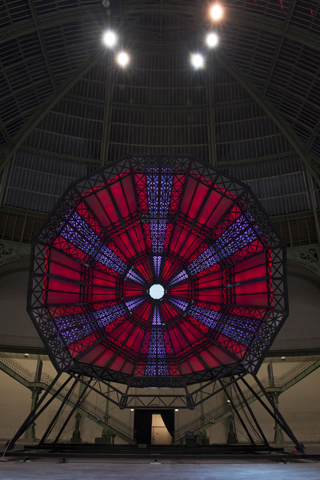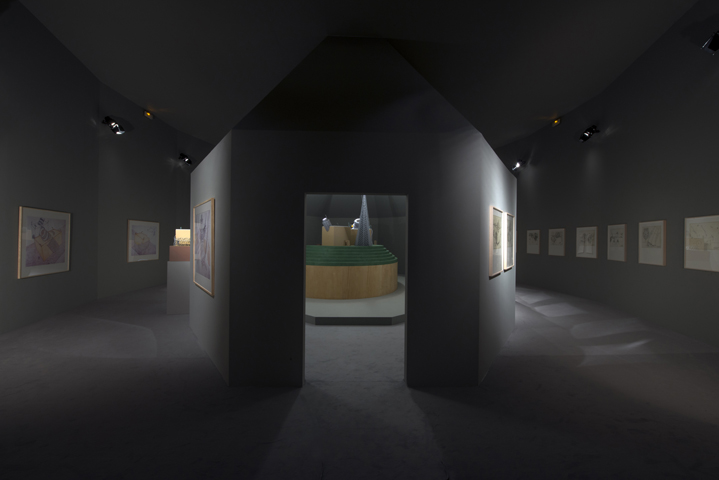White Space, No Cubes: Ilya and Emilia Kabakov’s “Strange City” at Monumenta Grand Palais
- (first published on artlifemagazine.com)
- May 15, 2014
- 4 min read
Updated: Mar 24, 2020
(Paris.) Earlier editions of Grand Palais’ Monumenta series have brought us excellent installations from the likes of Richard Serra (2008), Christian Boltanski (2010), or Anish Kapoor (2011). In 2012, it was up to Daniel Buren to occupy all the main hall of Grand Palais and, well, the result was not exactly overwhelming. Let’s just say, Buren’s work lacked the necessary monumentalism. “Boring” would be the nicest word to describe his show. The then freshly elected French President visited the 2012 opening himself, and some months later news broke out that the 2013 edition was cancelled for financial reasons – the Ministry of Culture had denied any further support. To imagine a connection here would be highly unfair, and completely speculative.
This year, Monumenta is back, with Ilya and Emilia Kabakov: Strange City, and it sure was worth the wait. The Ukrainian (then USSR) born, US resident couple has built a city (or with a bit of modesty: village) under Grand Palais’ mighty glass dome, and shows just how monumental it can get.
Entering the Grand Palais, visitors see nothing but a great white wall and a sign prohibiting “phones”, “noise” and “selfies”(!). The Palais guides are quick to assure that this is only an ironic statement by the artists – you may do as you please. Walking along the wall, chatting loudly on the phone while taking selfies, you’ll arrive at an oversized desk lamp. “Oversized” meaning 15x16 m (that’s 49ft 55in x 52ft 23in) with a diameter of 13.5m (44ft 3in) and a weight of 24t.
This “lamp” aims down on what lies behind the wall – menacing like a sci-fi laser cannon? But the light only shows inside the “shade”, and it’s a show playing in multiple colours. The design also continues the lines of Grand Palais’ iconic roof. Add spherical Ambient Music – at times even a live concert – and you understand why people are lying down in silence.
One less impressive detail is the blank square in the uppermost internal spot of the construction, it looks a bit like the artwork’s dirty underwear.
After this prelude, we’re ready to enter the Strange City beyond the wall. During ten days of preparation, the Kabakovs indeed installed (ordered to install) seven large buildings, and we’re talking about solid stone buildings – no wood -, all painted in bright gallery-white.
The buildings serve as museums – or mausoleums, is this a sort of necropolis? It’s definitely not a city to live in, people are but visitors here. Ilya and Emilia Kabakov’s Strange City is inhabited by ideas, by art, light and forms. Each building is dedicated to another trope, from Gates to Manas to Angels. To enter them, you’ll need to pass a cotton rag obstructing a part of the open door (“If you are this tall, you may not play here”? No, probably necessary to block out the light; it will polish your forehead nicely). The typical floor plan comprises one central chamber with a big wood sculpture, and a circular corridor with drawings and smaller wood sculptures leading around it.
So in Manas, the name of a fictional Tibetan city in Shangri-La’s banlieue: A city in the city in the Palais in the city. Like a Russian doll. The wooden architectural models - for their part named The House of Dreams, Two Antennas, The Sky Gardens and the Waterfalls, etc. - remind of termite mounds, or, more poetical: observatory/temple hybrids. Seriously: the objects and drawing are great, and there’s (probably) a meaning to every detail, so one could spend hours in here alone. The same goes for How to Meet an Angel: Its central sculpture consists of a large coffin form with a small house and a big tower (/diving platform) on top. On top of the tower stands a man reaching up to an angel under heavenly light. Around, we find the same in a smaller version, together with angel drawings in various styles (from minimalist to Chagal-esque), and even a pair of strap-on wings.
The Centre of Cosmic Energy and The Gates are not less impressive. Three houses – The Empty Museum, The White Chapel (not: “Gallery”) and The Dark Chapel - are different.
Even larger than the others, the Chapels are reserved to Ilya and Emilia Kabakov’s paintings. Monumental works covering dark walls in silence vs. small painted mosaics on white tiles with the sound of ringing bells. The Empty Museum unsurprisingly accommodates no works in classic sense, but wooden seats halfway between museum benches and church pews, royal-red walls, and a fake door at the back end. Spotlights “paint” white planes on the walls, the blank spots of monochrome abstraction, while sacral music (Bach?) intensifies the grave atmosphere.
The basic idea of Ilya and Emilia Kabakov’s The Strange City for Monumenta at Grand Palais, is to question “the great visions of progress, science, and human upliftment, that could have led to the brink of disaster” (Ilya Kabakov in the exhibition leaflet). Amongst much more, there’s art, esoterism and religion, not to forget the occasional nod to Tatlin and architectural utopias. The Strange City is a great, and a huge, work, in which it’s easy to get lost, literally as well as mentally. The Grand Palais regularly hosts art fairs, but no fair booth could match one of the Kabakov’s constructions. This “installation” goes from the largest to the smallest. It’s one monumental unity, yet each single drawing could as well stand for its own.
A museum in the museum that offers an eclectic insight to the artists' oeuvre; a profound reflection on the history of man and ideas, en passant questioning the difference between art and architecture, this year's Monumenta is a must-see.
The emergency exits in the Strange City’s walls are – though very geometrically placed – not part of the artwork, but a legal obligation.
For those who like to play treasure hunt: can you find the trashcan hidden in the city?
Ilya and Emilia Kabakov, The Strange City, Monumenta 2014, 10 May-22 June 2014, Grand Palais, Paris












Comments